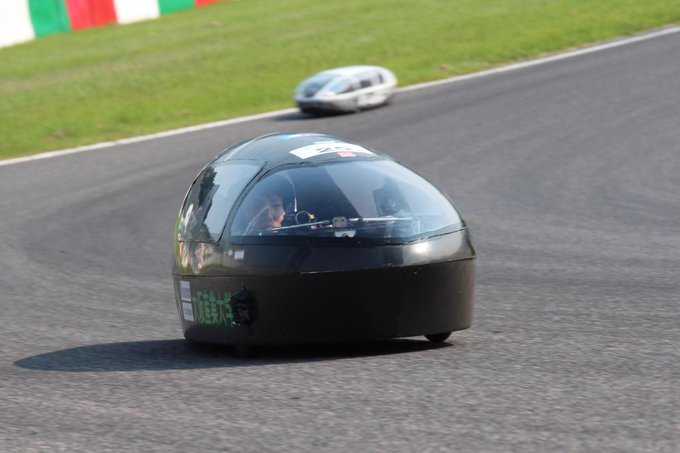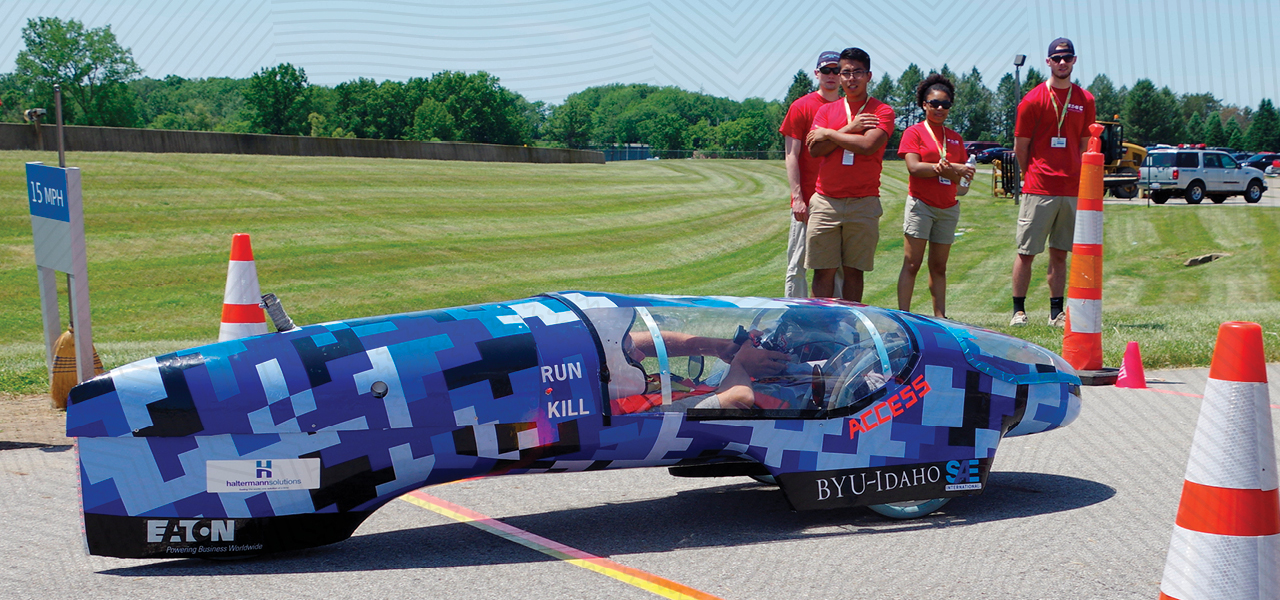In my last post, I shared my recent discovery about the Eco-Racer and its true heritage. Originally, I believed the Eco-Racer was Osaka Sangyo University’s ENE-1 GP racer from 2011 to 2017. However, I took a closer look. I discovered these were actually separate vehicles! The ENE-1 GP racer had several differences in its construction compared to what I had. This included a different design for it’s canopy and tail cowling, and a different steering system. This led me to believe that my car was either an earlier prototype, or possibly the earliest version of the ENE-1 GP racer from 2011. I concluded that post by mentioning that I had reached out to the University for more clarification. All that was left to do was to wait for an answer. Well, I’m happy to say that answer came! Here it is; the final word on the Eco-Racer!
An Early Morning Email
I awoke to an email in my inbox with a Japanese email address. Upon inspection, I discovered the email was from a gentlemen named Takashi Sudo. If that name doesn’t sound familiar, maybe this picture would provide a clue:

Takashi Sudo is one of the designers, builders, and the actual driver of OSU’s Panasonic Oxyride Race Car from 2007! This car was built by the university in an attempt to set the speed record for a AA battery-powered car. They succeeded, and made it into the 2007 Guinness Book of World Records for setting a speed of 65.83 mph!
In his email, he very kindly explained to me that the he was one of the people that worked on my car! In fact, he was a teacher during the duration of the project. According to him, my car is in fact a sister car built by a team of interns from Stanford University studying carbon fiber reinforced plastics manufacturing in 2009! This means that my car and the ENE-1 GP Racer were both made at the same time in the summer of 2009!

Takashi Sudo went on to explain that he was the person who helped design and manufacture my car. He participated in the ENE-1 GP, and can be seen in the photos I shared working on the ENE-1 GP car at Twin Ring Motegi. In my last email exchange, he stated he was currently making a smaller car to compete in the next ENE-1 GP.

Here is the original email in its entirety below:
Dear Mr.Wayne
– Takashi Sudo
Nice to meet you. This is Takashi Sudo.
At that time, I designed and manufactured the car in the photo at Osaka
Sangyo University.
sorry. Since I am using translation software, the text may be strange.
Thank you for researching the cars we made.
This car was specially designed for students who came to an internship
from Stanford University in 2009 to learn about CFRP in a group called
New Energy Vehicle Project, Osaka Sangyo University when I was just a
teacher at that time. ..
At first I participated in the battery competition Ene-1GP to compete
for the ranking, but it is so big for us to ride, so now I am making a
small car and participating, and now I am a driver I am participating as
a practice car. There used to be a lot of photos, but my computer broke and there are almost no photos left. sorry
For inquiries about electric vehicles
Also, when I was a student, I made and rode an Oxyride Battery Vehicle.
Now that I’m away from my teacher’s job and working as a clerk at Osaka
Sangyo University, it’s difficult to make a new car, but I’ll be
participating in the 2021 Ene-1GP!
If you have any questions, please contact us.
Thank you
I couldn’t believe it! Here was definitive proof of the history of the car straight from the source! But, I still had a lot of questions. If my car was the sister car to the ENE-1 GP racer, then why were there differences in the canopy design and the steering system? Also, I wanted to know if my car raced as the previous owners once stated, and what was used for the original power source. I wrote another email to Takashi Sudo (with translation from English to Japanese) with the hopes of gaining a clearer insight into my car.
The “Super-Sanda”
Takashi Sudo replied to my second email and provided much needed insight into the design of my car. Originally, the OSU car was developed for a race series called the “World Econo Move GP”; a race series similar to the ENE-1 GP in which electric cars powered by 2-4 motorcycle batteries competed for endurance. According to Takashi Sudo, the first race the car attended was at the Eco Car Festa 2009 for the 4th round of the 2009 World Econo Move GP. From what I was able to gather, this race was held at Sportsland Ikoma between September 22nd and 23rd. Unfortunately, I couldn’t find pictures of the car at the race, but did find a photo of the participants of the race, as well as the practice, qualifying, and race results. The OSU race car was listed as car No.9 “Super-Sanda”, and placed 10th overall with 47 laps completed!


Takashi Sudo went on to explain that while the OSU “Super-Sanda” was designed for the World Econo Move GP, its sister car was the car developed at the same time by the student intern team from Stanford University. The Stanford car was designed and built using the same molds that were used for the Super-Sanda, but with slight differences in its construction that set it apart from the original car. So why were there differences in the design of the Stanford car and the Super-Sanda?
The Stanford Car

Takashi Sudo explained in his email that the he had designed and built both cars in the same shape in order to make the manufacturing process more simple. Both cars were actually completed at the same time, but, Takashi Sudo and the students decided to utilize different concepts for each car. For easier clarification, I’ll be referring to The Stanford University Car as #1, and the OSU Car as #2.
The most notable difference between the cars were the design of the canopies and bulkheads. #1 utilizes a two-piece canopy and tail cowl, whereas #2 uses one solid piece. Takashi Sudo explained that car #1 was designed so that less people were needed to carry the canopy and service the car. This meant that a smaller team could use the car at events. The bulkhead of #1 was also designed to not only position the canopy and the tail cowl for better airflow, but also acted as a built in rollbar to protect the driver in case of a rollover. Car #2’s canopy was designed for ease of access of vital equipment, and to be more aerodynamic. Because #2 was used as a research car, the team needed to access the testing equipment more quickly.

As for the differences in the steering system, Takashi Sudo provided enlightenment. Both cars use a slightly different steering system from each other. In car #2, the steering system was developed to resemble the steering system in a typical car. This in theory made it simple to operate, as it would operate just like a road car. However, Takashi Sudo had difficulties keeping the car straight with this type of steering because his arms would float in the air during operation. So when the steering system in car #1 was designed, it more resembled the steering system for a motorcycle. The mechanisms were also slightly lowered as opposed to car #2. This made it so that the arms would be extended and resting on the driver’s abdomen during operation, which made it easier to keep the car straight when in motion.
In other words, car #1 (the Eco-Racer) has a small set of improvements over the original car. I have yet to take the Eco-Racer out for a test drive, so we’ll have to see how easy it is to steer!
The Final Word

While both cars were developed and completed around the same time, only the OSU car was used for racing. Takashi Sudo explained that the Eco-Racer was sent to the United States upon completion of the project. It would eventually end up in the hands of one of the students that worked on the Eco-Racer, and ultimately into my own hands. As for the OSU car; it was used for various events and demonstrations, including participating in the ENE-1 GP. As of now, the original OSU car is no longer being used for demonstrations as far as I can tell.
When I became the owner of the Eco-Racer, I only had a vague idea of where it came from based on what I was told. Little did I know, I would embark on an incredible journey rediscovering the history of this brilliant machine! In my last email to Takashi Sudo, I had asked him to kindly share our email exchange with the university so that anyone else who might have been involved with the project would be able to share their experiences. While it’s unfortunate that Takashi Sudo’s records of the both vehicles were lost, but perhaps someone else may have something? Maybe they’ll be excited to see the Eco-Racer alive and well in the USA!
Right now, the Eco-Racer is currently sitting in storage as I’m going to be moving to a new location soon. But, as soon as I’m settled, I’m getting this thing back on the road again!
A very special thanks to Takashi Sudo for reaching out to me and revealing the history of this car! I am looking forward to hearing more from you my friend!
-W




























